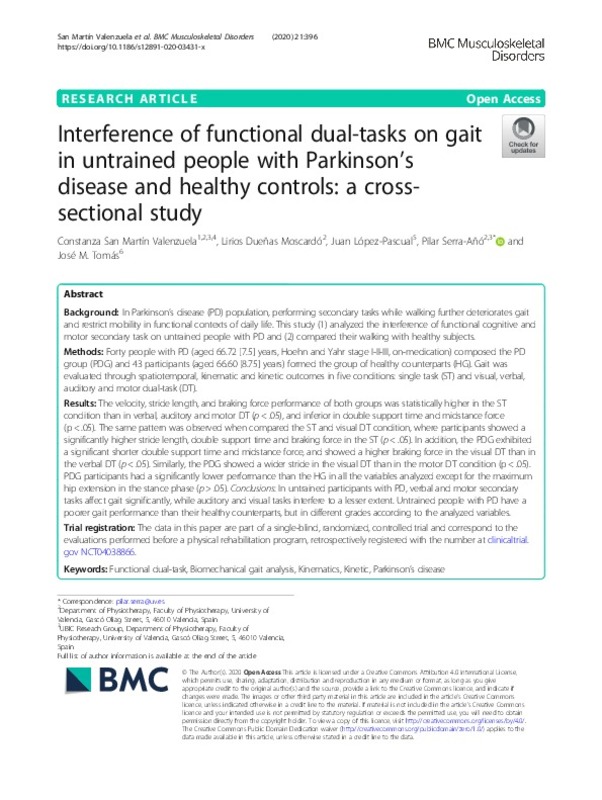Jankovic J. Parkinson’s disease: clinical features and diagnosis. J Neurol Neurosurg Psychiatry. 2008;79:368–76.
Soh S-E, McGinley JL, Watts JJ, Iansek R, Murphy AT, Menz HB, et al. Determinants of health-related quality of life in people with Parkinson’s disease: a path analysis. Qual Life Res. 2013;22:1543–53.
Tan D, Danoudis M, McGinley J, Morris ME. Relationships between motor aspects of gait impairments and activity limitations in people with Parkinson’s disease: a systematic review. Parkinsonism Relat Disord. 2012;18:117–24.
[+]
Jankovic J. Parkinson’s disease: clinical features and diagnosis. J Neurol Neurosurg Psychiatry. 2008;79:368–76.
Soh S-E, McGinley JL, Watts JJ, Iansek R, Murphy AT, Menz HB, et al. Determinants of health-related quality of life in people with Parkinson’s disease: a path analysis. Qual Life Res. 2013;22:1543–53.
Tan D, Danoudis M, McGinley J, Morris ME. Relationships between motor aspects of gait impairments and activity limitations in people with Parkinson’s disease: a systematic review. Parkinsonism Relat Disord. 2012;18:117–24.
Kelly VE, Eusterbrock AJ, Shumway-Cook A. A review of dual-task walking deficits in people with Parkinson’s disease: motor and cognitive contributions, mechanisms, and clinical implications. Parkinson’s Disease. 2012;918719.
Sofuwa O, Nieuwboer A, Desloovere K, Willems A-M, Chavret F, Jonkers I. Quantitative gait analysis in Parkinson’s disease: comparison with a healthy control group. Arch Phys Med Rehabil. 2005;86:1007–13.
Beauchet O, Berrut G. Gait and dual-task: definition, interest, and perspectives in the elderly. Psychologie et NeuroPsychiatrie du Vieillissement. 2006;4:215–25.
Raffegeau TE, Krehbiel LM, Kang N, Thijs FJ, Altmann LJP, Cauraugh JH, et al. A meta-analysis: Parkinson’s disease and dual-task walking. Parkinsonism Relat Disord. 2019 May;62:28–35.
Eric R. Kandel, James H. Schwartz, Thomas M. Jessell, Steven a. Siegelbaum, A. J. Hudspeth. Principles of neural science. Fifth edition. McGraw-Hill Medical: United States of America; 2013.
Eisinger RS, Cernera S, Gittis A, Gunduz A, Okun MS. A review of basal ganglia circuits and physiology: application to deep brain stimulation. Parkinsonism Relat Disord. 2019 Feb;59:9–20.
Isella V, Mapelli C, Morielli N, De Gaspari D, Siri C, Pezzoli G, et al. Validity and metric of MiniMental Parkinson and MiniMental state examination in Parkinson’s disease. Neurol Sci. 2013;34:1751–8.
Morris ME, McGinley J, Huxham F, Collier J, Iansek R. Constraints on the kinetic, kinematic and spatiotemporal parameters of gait in Parkinson’s disease. Hum Mov Sci. 1999;18:461–83.
Brauer SG, Morris ME. Can people with Parkinson’s disease improve dual tasking when walking? Gait & Posture. 2010;31:229–33.
Baron EI, Miller Koop M, Streicher MC, Rosenfeldt AB, Alberts JL. Altered kinematics of arm swing in Parkinson’s disease patients indicates declines in gait under dual-task conditions. Parkinsonism Relat Disord. 2018;48:61–7.
Rochester L, Galna B, Lord S, Burn D. The nature of dual-task interference during gait in incident Parkinson’s disease. Neuroscience. 2014;265:83–94.
Logan D, Kiemel T, Dominici N, Cappellini G, Ivanenko Y, Lacquaniti F, et al. The many roles of vision during walking. Exp Brain Res. 2010;206:337–50.
de Luna RA, Mihailovic A, Nguyen AM, Friedman DS, Gitlin LN, Ramulu PY. The Association of Glaucomatous Visual Field Loss and Balance. Transl Vis Sci Technol. 2017 May 22;6(3):8.
Suarez H, Geisinger D, Ferreira ED, Nogueira S, Arocena S, Roman CS, et al. Balance in Parkinson’s disease patients changing the visual input. Brazilian Journal of Otorhinolaryngology. 2011;77:651–5.
Wu T, Hallett M. Neural correlates of dual task performance in patients with Parkinson’s disease. J Neurol Neurosurg Psychiatry. 2008;79:760–6.
Canning CG. The effect of directing attention during walking under dual-task conditions in Parkinson’s disease. Parkinsonism Relat Disord. 2005;11:95–9.
Wu T, Liu J, Zhang H, Hallett M, Zheng Z, Chan P. Attention to automatic movements in Parkinson’s disease: modified automatic mode in the striatum. Cereb Cortex. 2015;25:3330–42.
de Roiz R. M, Cacho EWA, Pazinatto MM, Reis JG, Cliquet a. Barasnevicius-Quagliato EMA Gait analysis comparing Parkinson’s disease with healthy elderly subjects Arq Neuropsiquiatr. 2010;68:81–6.
Grabli D, Karachi C, Welter M-L, Lau B, Hirsch EC, Vidailhet M, et al. Normal and pathological gait: what we learn from Parkinson’s disease. J Neurol Neurosurg Psychiatry. 2012 Oct;83(10):979–85.
Anna C, Serena F, Maurizio F. Del Sorbo Francesca, Romito Luigi M., Elia Antonio E., et al. quantitative gait analysis in parkin disease: possible role of dystonia. Mov Disord. 2016;31:1720–8.
Morris M, Iansek R, McGinley J, Matyas T, Huxham F. Three-dimensional gait biomechanics in Parkinson’s disease: evidence for a centrally mediated amplitude regulation disorder. Mov Disord. 2005;20:40–50.
Peterson CL, Kautz SA, Neptune RR. Braking and propulsive impulses increase with speed during accelerated and decelerated walking. Gait Posture. 2011;33:562–7.
Chiu M-C, Wang M-J. The effect of gait speed and gender on perceived exertion, muscle activity, joint motion of lower extremity, ground reaction force and heart rate during normal walking. Gait & Posture. 2007;25:385–92.
Muniz AMS, Liu H, Lyons KE, Pahwa R, Liu W, Nobre FF, et al. Comparison among probabilistic neural network, support vector machine and logistic regression for evaluating the effect of subthalamic stimulation in Parkinson disease on ground reaction force during gait. J Biomech. 2010;43:720–6.
Chastan N, Do MC, Bonneville F, Torny F, Bloch F, Westby GWM, et al. Gait and balance disorders in Parkinson’s disease: impaired active braking of the fall of Centre of gravity. Mov Disord. 2009;24:188–95.
Perneger T. What's wrong with Bonferroni adjustments. BMJ. 1998 Apr 18;316(7139):1236–8.
[-]








